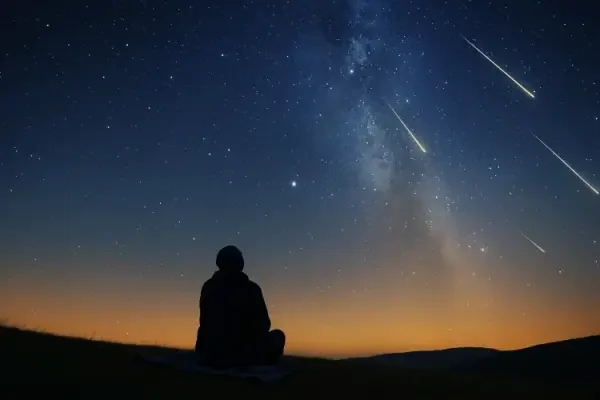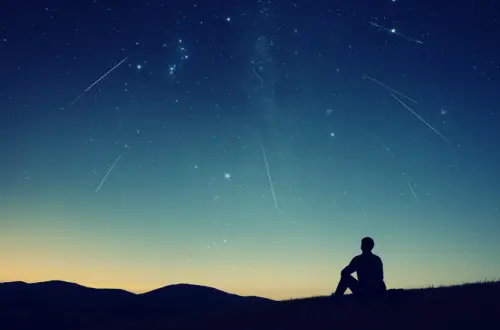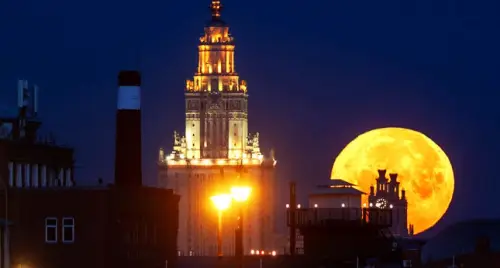Meteor Showers. Every year, as the nights grow longer and the air turns crisp, the cosmos invites us to witness its silent, breathtaking ballet.
Far from the glow of city lights, the universe unfolds in a spectacle of falling stars, ancient comets, and radiant moons. This autumn is no exception, offering a celestial calendar packed with events that have captivated humanity for millennia.
It’s a chance to lay back, look up, and reconnect with the vast, glittering expanse above. From the swift, bright streaks of the Orionids to the grand finale of the Geminids, prepare to be mesmerized. This is your ultimate guide to a season of cosmic wonder.
Meteor Showers, The Orionids.
Echoes of Halley’s Comet.
Each October, the night sky presents one of its most reliable and beautiful performances: the Orionid meteor shower.
These fleeting streaks of light are more than just a pretty display; they are a direct, tangible link to one of the most famous celestial objects in history- Halley’s Comet (1P/Halley).
A Legacy Written in Dust.
Imagine a celestial wanderer, a frozen giant of ice, rock, and dust, journeying through the cold, dark void of space. That is Halley’s Comet. For centuries, it has faithfully returned to our inner solar system every 76 years, a silent visitor witnessed by generations.
Its appearances have been recorded by civilizations across the globe, often seen as a powerful omen, a harbinger of change, or a divine message.
It was the English astronomer Edmond Halley who, in 1705, first realized that the comets observed in 1531, 1607, and 1682 were, in fact, the same object, and he correctly predicted its return in 1758.
His discovery transformed comets from mystical portents into predictable, physical members of our solar system.
As this legendary comet travels on its vast elliptical orbit, the Sun’s heat causes it to shed a stream of dust and debris, leaving behind a cosmic trail like breadcrumbs in space.
Twice a year, Earth’s own orbit intersects this ancient river of dust. In October, we pass through this trail, and the result is the Orionid meteor shower.
The tiny particles, most no larger than a grain of rice, slam into our planet’s atmosphere at an astonishing speed of approximately 66 kilometers per second (about 148,000 miles per hour). To put that into perspective, it’s nearly 200 times faster than a speeding bullet.
The immense kinetic energy of these particles is instantly converted into heat and light upon impact with air molecules, creating the brilliant, incandescent streaks we call “falling stars.”
They are the fiery last moments of ancient cometary dust, burning up in a blaze of glory some 100 kilometers above our heads.
When and Where to Watch the Spectacle.
The Orionids are active from early October to early November, but the show truly climaxes during its peak. This year, the peak is expected on the night of October 20th into the early morning of the 21st.
Under ideal conditions, you can expect to see up to 20 meteors per hour. What makes this year’s event particularly special is the phase of the Moon. With the Moon in its new phase, the sky will be perfectly dark, providing a velvety black canvas for the Orionids to paint their fleeting masterpieces.
To find the meteors, you don’t need any special equipment, just your eyes. While the meteors can appear anywhere in the sky, they will all seem to originate from a single point, known as the radiant.
The radiant for the Orionids is located in the famous constellation of Orion the Hunter. You can easily spot Orion by its three bright stars forming a straight line the iconic “Orion’s Belt.” Look slightly above the belt, near the mighty red giant star Betelgeuse, and you’ll be looking in the direction of the radiant.
The best time to watch is from midnight until dawn. This is when the constellation of Orion has climbed high into the sky, placing the radiant in an optimal viewing position. And the beauty of the Orionids is their global reach; they are visible from anywhere on Earth.
Tips for a Perfect Night of Stargazing.
1. Escape the City: The single most important factor for a successful meteor shower viewing is a dark sky. Find a location far away from the light pollution of cities and towns. A national park, a remote field, or even a quiet suburban backyard with few streetlights can make all the difference.
2. Get Comfortable: You’ll be spending a lot of time looking up, so comfort is key. Bring a reclining chair, a thick blanket, or a sleeping bag to lie on the ground.
3. Dress Warmly: October nights can be chilly. Dress in layers, wear a hat and gloves, and bring a thermos filled with a hot drink like tea or hot chocolate to stay warm.
4. Let Your Eyes Adjust: It takes about 15-20 minutes for your eyes to become fully adapted to the darkness. Once they have, you’ll be able to see much fainter meteors. Avoid looking at bright screens, like your phone, as it will reset your night vision. If you need a light, use a red-light flashlight, which is much less disruptive.
5. Be Patient: Meteor watching is a game of patience. There will be lulls, followed by bursts of activity. Relax, enjoy the starry sky, and let the show come to you. Don’t forget to make a wish!
Interestingly, scientists have noted that in some years, the Orionids can experience an outburst, rivaling the intensity of the famous summer Perseids with rates of 50-75 meteors per hour. So, the chance to witness a truly spectacular celestial firework display is always there.
The Taurids and a Supermoon.
A November Double Feature.
As we move into November, the celestial calendar offers two distinct but equally captivating events: the slow, majestic fireballs of the Taurid meteor shower and the breathtaking sight of the year’s largest Supermoon.
The Taurids.
The Fireballs of Halloween.
From November 3rd to 7th, the night sky will be graced by one of the most beautiful, though not the most prolific, meteor showers the Taurids.
What the Taurids lack in numbers (averaging about 5-7 meteors per hour), they more than make up for in quality. They are renowned for producing exceptionally bright and long-lasting meteors known as bolides or fireballs.
These can be so brilliant that they cast shadows on the ground and leave behind smoky trails that linger in the sky for several seconds.
This year, the Taurids’ activity is expected to be enhanced due to a rare “swarm” year. This occurs when Earth passes through a denser stream of debris left by the shower’s parent body, Comet Encke. This means a higher chance of witnessing those unforgettable, blazing fireballs.
The Taurids actually consist of two separate streams the Southern Taurids (peaking around November 5th) and the Northern Taurids (peaking around November 12th).
The Supermoon of November 5th.
On the very same night as the Southern Taurids’ peak, November 5th, we will be treated to the largest Supermoon of 2025. A Supermoon occurs when the full Moon coincides with its closest approach to Earth in its elliptical orbit, a point known as perigee.
On this night, the Moon will appear approximately 8% larger and 16% brighter than an average full Moon.
While this difference may be subtle to the naked eye, you can enhance the experience using a simple trick known as the “moon illusion.” Observe the Moon as it rises above the horizon, where you can frame it against terrestrial objects like trees, buildings, or mountains.
This comparison creates a powerful optical illusion, making the Moon appear truly immense and spectacular. It’s a perfect opportunity for breathtaking photography and a serene evening walk under the glow of our celestial neighbor.
However, the brightness of the Supermoon will make it more challenging to spot the fainter Taurid meteors, so try to find a viewing spot where the Moon’s light is at least partially obscured.
The Geminids, Grand Finale.
December brings the undisputed king of all meteor showers—the Geminids. Peaking on the night of December 14th, this is the most powerful and reliable meteor shower of the year, promising a celestial display of unparalleled intensity.
Under dark skies, the Geminids can produce an astonishing 150 meteors per hour that’s more than two per minute!
What makes the Geminids so unique is their origin. Unlike most meteor showers, which originate from icy comets, the Geminids are the product of an asteroid: 3200 Phaethon.
Phaethon is a mysterious and fascinating object, sometimes referred to as a “rock comet.” It has an orbit that brings it incredibly close to the Sun, and scientists believe that the intense solar heating causes its rocky surface to fracture and release a trail of dusty debris, which we see as the Geminid meteor shower.
Geminid meteors are known for being bright, fast, and sometimes vividly colored. Observers often report seeing meteors in shades of yellow, green, and blue. The waning Moon on the night of the peak will not significantly interfere with the show, especially after it sets.
For the best experience, plan to watch after midnight. Bundle up in your warmest clothes, grab that thermos, and prepare for a night you won’t soon forget.
The Geminids are the perfect celestial event for romantics, astronomy enthusiasts, and anyone looking to end the year by making a hundred wishes upon a hundred falling stars.
Have a Great Night!




